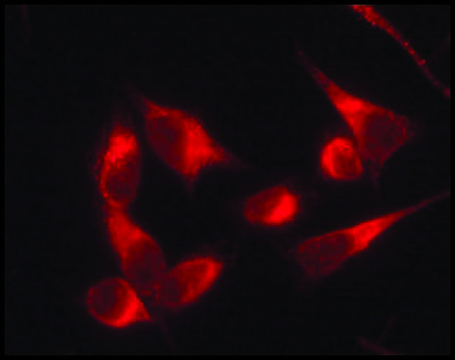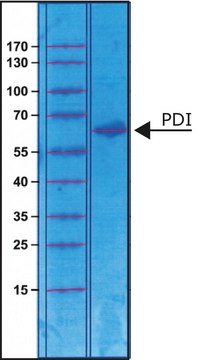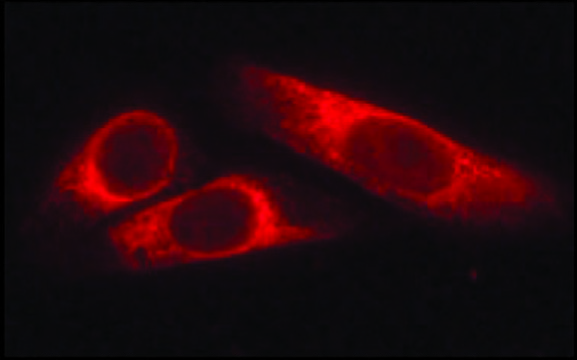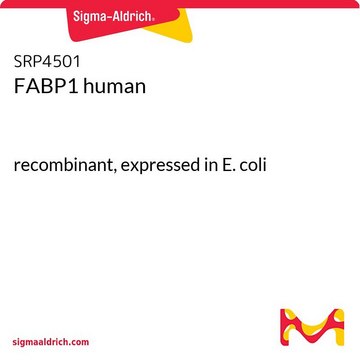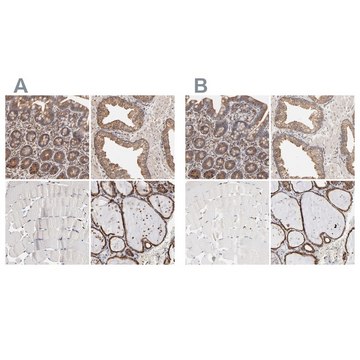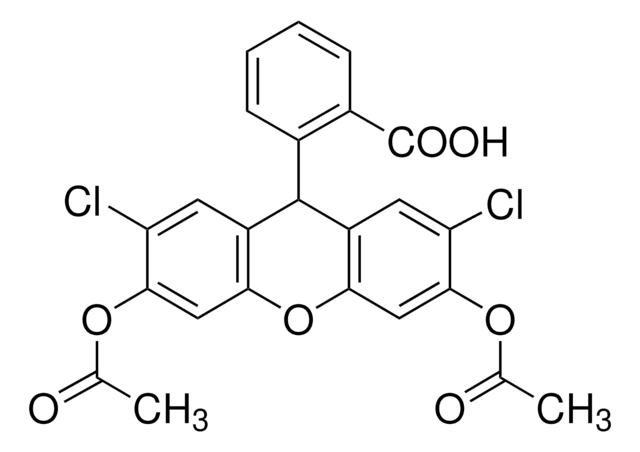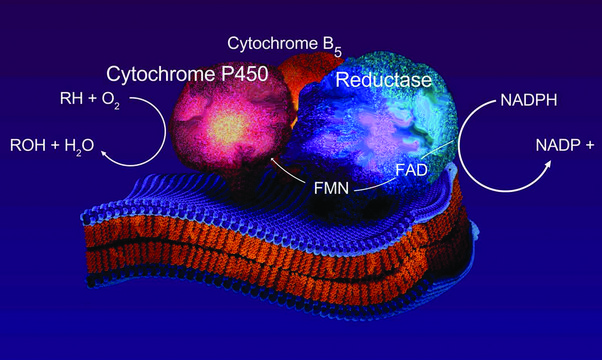推荐产品
生物来源
rabbit
质量水平
偶联物
unconjugated
抗体形式
affinity isolated antibody
抗体产品类型
primary antibodies
克隆
polyclonal
表单
buffered aqueous solution
分子量
antigen 57 kDa
种属反应性
human, bovine, rat, mouse
增强验证
independent
Learn more about Antibody Enhanced Validation
技术
immunoprecipitation (IP): 2-5 μg using RIPA lysate (500 μg) of rat NRK cells
indirect immunofluorescence: 2-5 μg/mL using human HeLa cells
western blot (chemiluminescent): 0.1-0.2 μg/mL using whole extract of mouse NIH3T3 cells
UniProt登记号
运输
dry ice
储存温度
−20°C
靶向翻译后修饰
unmodified
基因信息
human ... P4HB(5034)
mouse ... P4hb(18453)
rat ... P4hb(25506)
一般描述
Anti-Protein Disulfide Isomerase (PDI) (MD-12) is developed in rabbit using as immunogen a synthetic peptide corresponding to amino acid residues of human PDI with N-terminal added cysteine, conjugated to KLH. Protein disulfide isomerase (PDI, Erp58) is an abundant multifunctional, soluble enzyme (E.C. 5.3.4.1) that resides in the lumen of the endoplasmic reticulum of eukaryotic cells. The mammalian PDI family comprises several highly divergent proteins that contain one or more thioredoxin like structural domains. PDI consists of four tandem domains, two of which contain a catalytic site for S-S bond formation. PDI has an N-terminal ER signal and C-terminal ER retention KDEL signal sequences. PDI may also be expressed in other cellular localizations such as the cell surface, cytosol, and nucleus. PDI was found on the cell surface of several cell types including platelets, lymphoid cells, pancreatic exocrine cells, retinal cells, thyroid cells, and hepatocytes.
免疫原
synthetic peptide corresponding to amino acid residues 495-506 of human protein disulfide isomerase.
应用
Anti-Protein Disulfide Isomerase (MD-12) antibody produced in rabbit has been used in:
- immunoblotting
- immunoprecipitation
- immunofluorescence
生化/生理作用
Protein disulfide isomerase (PDI) catalyses the formation and rearrangements of both intrachain and interchain disulfide bonds in secreted proteins. PDI also serves as a molecular chaperone that can suppress protein aggregation, or as an anti-chaperone that mediates aggregate formation. PDI respectively participates in the hydroxylation of prolines in procollagen during collagen synthesis and in the transfer of neutral lipid onto nascent lipoprotein particles. PDI has calcium-dependent transglutaminase activity, which catalyses the formation of isopeptide bonds.
外形
Solution in 0.01 M phosphate buffered saline containing 1% bovine serum abumin and 15 mM sodium azide.
免责声明
Unless otherwise stated in our catalog or other company documentation accompanying the product(s), our products are intended for research use only and are not to be used for any other purpose, which includes but is not limited to, unauthorized commercial uses, in vitro diagnostic uses, ex vivo or in vivo therapeutic uses or any type of consumption or application to humans or animals.
未找到合适的产品?
试试我们的产品选型工具.
储存分类代码
10 - Combustible liquids
WGK
nwg
闪点(°F)
Not applicable
闪点(°C)
Not applicable
法规信息
含少量动物源组分生物产品
常规特殊物品
Hongge Wang et al.
Molecular and cellular biology, 42(6), e0052221-e0052221 (2022-05-03)
Ferroptosis is a form of regulated cell death resulting predominantly from catastrophic accumulation of lipid reactive oxygen species (ROS). While the antioxidant systems that counter ferroptosis have been well characterized, the mechanism underlying ferroptosis-associated accumulation of lipid ROS remains unclear.
Dual targeting of the protein disulfide isomerase RB60 to the chloroplast and the endoplasmic reticulum
Levitan A, et al.
Proceedings of the National Academy of Sciences of the USA, 102(17), 6225-6230 (2005)
Protein disulfide isomerase. A multifunctional protein resident in the lumen of the endoplasmic reticulum.
Noiva R and Lennarz WJ
The Journal of Biological Chemistry, 267(6), 3553-3556 (1992)
Ming-Jie Hou et al.
Acta biochimica et biophysica Sinica, 55(5), 853-865 (2023-05-30)
Ferroptosis is a new form of nonapoptotic cell death closely associated with glutathione (GSH) peroxidase 4 inhibition and/or GSH depletion, resulting in the accumulation of cellular iron and lipid peroxides. The exact mechanism by which GSH depletion causes the accumulation
Facilitated protein aggregation effects of calcium on the chaperone and anti-chaperone activity of protein disulfide-isomerase
Primm TP, et al.
The Journal of Biological Chemistry, 271(52), 33664-33669 (1996)
我们的科学家团队拥有各种研究领域经验,包括生命科学、材料科学、化学合成、色谱、分析及许多其他领域.
联系技术服务部门
